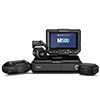Timeline

Timeline
A Legacy of Innovation: Timeline of Motorola history since 1928
Since 1928, Motorola has been committed to innovation in communications and electronics. Our company has achieved many milestones in its 85-plus year history. We pioneered mobile communications in the 1930s with car radios and public safety networks. We made the equipment that carried the first words from the moon in 1969. In 1983 we led the communications revolution with the first commercial handheld cellular phone and system. Today, as a global industry leader, excellence in innovation continues to shape our future.

1928: Founding of Company
On September 25, 1928, Paul V. Galvin and his brother, Joseph, incorporated Motorola's founding company—the Galvin Manufacturing Corporation—in Chicago, Illinois, USA.

1928: Battery Eliminator
Galvin Manufacturing Corporation's first product was a 1928 battery eliminator. This power converter allowed battery-powered radios to run on household electricity. The company's first customer was Sears, Roebuck and Co., which sold battery eliminators to consumers.

1930: First Motorola Brand Car Radio
In 1930 Galvin Manufacturing Corporation introduced the Motorola radio, one of the first commercially successful car radios. Company founder Paul V. Galvin created the brand name Motorola for the car radio -- linking "motor" (for motorcar) with "ola" (which implied sound). Thus the Motorola brand meant sound in motion.
1930: First Motorola Public Safety Radio Sales
Galvin Manufacturing Corporation began selling Motorola car radios to police departments and municipalities in November 1930. Among the first customers (all in the U.S. state of Illinois) were the Village of River Forest; Village of Bellwood Police Department; City of Evanston Police; Illinois State Highway Police; and Cook County (Chicago area) Police.
1930: International Motorola Sales
On June 18, 1930, Galvin Manufacturing Corporation sold two Motorola car radios to W. Oldenburger in Mexico City. This was the first recorded sale of a Motorola-branded product outside the United States.

1936: Motorola Police Cruiser Radio Receiver
In 1936 Galvin Manufacturing Corporation introduced the Motorola Police Cruiser radio receiver, a rugged one-way car radio designed to receive police broadcasts. The radio was tuned to a single frequency specified by the customer. The company had been providing Motorola radios for public safety use since 1930.

1937: Motorola Home Entertainment Radios
Galvin Manufacturing Corporation entered the home entertainment business in 1937 with a line of Motorola phonographs and home radios.

1938: National Motorola Advertising
The first Motorola national advertising campaign was underway in the U.S. by 1938. The campaign included print media, road signs and billboards.

1939: Motorola AM Two-Way Radio Equipment
In 1939 Galvin Manufacturing Corporation introduced a complete line of low-cost, dependable Motorola AM two-way radio equipment, including the model T6920 mobile transmitter. The company aimed to make radio equipment affordable for more public safety agencies to help them improve service to their communities.

1940: Handie-Talkie SCR536 Radio
In 1940 Galvin Manufacturing Corporation engineers developed the Handie-Talkie SCR536 AM portable two-way radio. This handheld radio became a World War II icon. The Handie-Talkie and other radios Galvin Manufacturing developed for the U.S. military at this time did not carry the Motorola brand.

1940: Motorola Research and Development Program
In 1940 Galvin Manufacturing Corporation increased its research and development program when Daniel E. Noble, an engineering professor and FM two-way radio pioneer, joined the company as director of research.

1941: Motorola FM Two-Way Radio Equipment
Galvin Manufacturing Corporation introduced a commercial line of Motorola FM mobile (car) two-way radio equipment in 1941. Police cars in the City of Philadelphia, Pennsylvania, USA, were equipped with the first production of Motorola FM equipment.

1943: World's First FM Portable Two-Way Radio
In 1943 Galvin Manufacturing Corporation designed the world's first FM portable two-way radio, the SCR300 backpack model, for the U.S. Army Signal Corps. Weighing 35 pounds (15.9 kg), the "walkie-talkie" radio had a range of 10 to 20 miles (16-32 km).

1944: Motorola Two-Way Radios for Taxis
In October 1944 Galvin Manufacturing Corporation installed Motorola radios in Yellow Cab Co. taxis in Cleveland, Ohio, the first commercial FM two-way taxi communications system in the United States.

1946: Motorola Car Radiotelephone
On October 2, 1946, Motorola communications equipment carried the first calls on Illinois Bell Telephone Company's new car radiotelephone service in Chicago. Due to the small number of radio frequencies available, the service quickly reached capacity.

1947: Company Name Change
In 1947 Galvin Manufacturing Corporation became Motorola, Inc.

1947: Portable Two-Way Radios for Business
Motorola introduced portable two-way radios designed especially for the industrial market in 1947.

1947: Motorola Dispatcher Two-Way Radios
The 1947 Motorola Dispatcher line of vehicular two-way radios used new radio channels for industrial customers in the United States.

1947: Motorola Golden View Televisions
Motorola introduced a line of Golden View televisions in 1947, beginning with the VK101 Consolette model. The Golden View VT71 table model television was designed to be affordable and more than 100,000 units sold in one year.
1953: Motorola Foundation
In 1953 Motorola established the Motorola Foundation to support leading universities in the United States. The foundation later expanded to support science, technology, engineering and math (STEM) education, and critical community needs globally where the company operated. Motorola Solutions Foundation continued this mission beginning in 2011.

1955: Stylized "M" Motorola Logo
In June 1955 Motorola introduced a new brand logo, the stylized "M" insignia, or "emsignia." Two aspiring triangle peaks arching into an abstracted "M" formed the basis of the new mark. It was chosen to typify the progressive leadership-minded outlook of the electronics company. The logo was designed by Morton Goldsholl, a Chicago designer.

1955: World's First Commercial High-Power Transistor
A 1955 Motorola germanium transistor for car radios was the world's first commercial high-power transistor. It was also Motorola's first mass-produced semiconductor.

1955: Motorola Handie-Talkie Paging System
Motorola's 1955 Handie-Talkie radio paging system provided individual paging inside hospitals, factories and office buildings, reducing noise from public address systems. The system included a selector console, an FM transmitter, and individual Handie-Talkie radio paging pocket receivers.

1956: Robert W. Galvin, President, Motorola, Inc.
Robert W. Galvin, son of company founder Paul V. Galvin, became president of Motorola, Inc. in 1956. After his father's death in 1959, Bob assumed full leadership of the company.

1958: Motorola Motrac Vehicular Two-Way Radio
In 1958 Motorola introduced the Motrac radio, the world's first vehicular two-way radio with a fully transistorized power supply and receiver. Its low power use enabled users to transmit without running their vehicles' engines.

1960: Motorola Astronaut TV
The 1960 Motorola Astronaut television, a 19-inch model, was the world's first large-screen, transistorized, cordless portable television.

1962: Motorola HT200 Portable Two-Way Radio
Motorola introduced the transistorized Handie-Talkie HT200 portable two-way radio in 1962. Small and lightweight at the time, it weighed 33 ounces (935 grams) and was nicknamed the "brick" because of its shape and durability.

1966: World's Smallest Prototype Pocket Television
In 1966, Motorola developed the world's smallest portable television receiver at the time. Four penlight batteries powered the 1.125 inch (2.86 cm) black and white experimental miniature set, referred to as the "Tiny Tim TV."

1969: First Words From the Moon
Motorola radio equipment relayed the first words from the moon to Earth on July 20, 1969. S-band transponders aboard the Apollo 11 lunar module and command module transmitted telemetry, voice communications, biomedical data and television signals between Earth and the moon. Motorola supplied the specially developed backpack antenna worn by astronaut Neil Armstrong, as well as equipment to process TV signals on Earth, and equipment responsible for range safety functions on all three stages of the Saturn V rocket and precision tracking during the launch phase.

1972: Motorola MODAT Vehicular Data Radio System
Motorola's 1972 MODAT mobile data radio system allowed users in vehicles to transmit and receive data from dispatch computers. Public safety officers could enter license plate information during traffic stops.

1973: World's First Portable Cellular Demonstration
On April 3, 1973, Motorola publicly demonstrated the world's first portable cellular telephone and system. The first public calls using Motorola DynaTAC (DYNamic Adaptive Total Area Coverage) technology occurred in New York City. Motorola engineers had been experimenting with radio communications in the 800 and 900 MHz bands since the 1960s.

1974: Motorola MC6800 Microprocessor
In 1974 Motorola introduced the 8-bit MC6800 microprocessor. The MC6800 microprocessor was used for automotive, computing and video game applications.

1975: Motorola MX300 Portable Radios
Motorola's 1975 MX300 series of portable two-way radios operated in the 900 MHz band. They included status, identification and emergency alert features that were compatible with computer-aided radio dispatch systems.

1977: First Digital Encryption Technology for Two-Way Radio Networks
Motorola's DVP Digital Voice Protection system, introduced in 1977, was the first digital encryption technology to provide two-way radio users with a very high degree of voice communications privacy. The first system was installed in Gabon, Africa, for an OPEC meeting. The FCC granted Salt Lake City, Utah, a developmental license, making it the first U.S. city to install the system for public safety use on standard channels.

1978: Motorola RDX1000 Portable Data Radio
Motorola introduced the RDX1000 handheld two-way data radio in 1978. The RDX portable data terminal system combined scanning and communications technology. Data could be captured by scanning, voice or keyboard input, and then transmitted wirelessly to a central computer. Potential applications included inventory control, freight traffic management, and industrial uses.

1983: World's First Commercial Portable Cellular Phone
The world's first commercial handheld cellular phone, the Motorola DynaTAC phone, received approval from the U.S. Federal Communications Commission on September 21, 1983. The 28-ounce (794-gram) phone became available to consumers in 1984.

1983: Motorola KDT800 Portable Two-Way Data System
In 1983 Motorola developed a radio network, later named ARDIS, that allowed IBM service technicians to use Motorola KDT800 portable two-way data radios to communicate with host computers. The radios functioned as wireless computer terminals.

1986: Six Sigma Quality Process
Motorola invented the Six Sigma quality improvement process in 1986. Six Sigma provided a common worldwide language for measuring quality and became a global standard.

1991: National Medal of Technology to Robert W. Galvin
Robert W. Galvin, a long-time Motorola leader and son of the company's founder, received the 1991 National Medal of Technology from U.S. President George Bush "for advancement of the American electronics industry through continuous technological innovation, establishing Motorola as a world-class electronics manufacturer."

1991: World's First Narrowband Digital Public Safety Radio System
Motorola's ASTRO two-way radio system, introduced in the U.S. in 1991, was the world's first narrowband digital public safety radio system. The New Hampshire, USA, State Police began extended field tests of ASTRO portables, mobiles, base stations, consoles, and a wide area system in December 1992.

1995: World's First Two-Way Pager
In 1995 Motorola introduced the world's first two-way pager, the Tango two-way personal messaging pager. It allowed users to receive text messages and e-mail, and reply with a standard response. It also could be connected to a computer to download long messages.

1996: Motorola TETRA Development
Motorola began alpha testing a TETRA radio system on the island of Jersey in March 1996. The company also was awarded a contract in 1996 to provide a TETRA system for the new Oslo Airport at Gardermoen, Norway.

2000: World's First 700 MHz Public Safety Wideband High-Speed Data Field Trial
In 2000 Motorola tested the world's first 700 MHz wideband high-speed data system for public safety users, enabling advanced mission-critical solutions. Pinellas County, Florida, USA, police, fire and EMS services deployed the trial system in 2001.

2004: Motorola National Medal of Technology
Motorola was awarded the 2004 National Medal of Technology "for over 75 years of technological achievement and leadership in the development of innovative electronic solutions, which have enabled portable and mobile communications to become the standard across society." Motorola received the award, the United States' highest honor for technological innovation, in a White House ceremony in February 2006.

2005: Motorola MOTOMESH Broadband Radio Network
In 2005 Motorola's MOTOMESH wireless mobile network was one of the first multiradio mesh networks to combine 4.9 GHz licensed mobile broadband radios and unlicensed Wi-Fi radios into a single access point. Mesh networking allowed public safety users to rapidly create a network of wireless devices linked in a relay system.

2006: Motorola MOTOTRBO Professional Digital Radios
Motorola introduced MOTOTRBO professional digital radio systems in 2006. The system offered businesses integrated voice and data applications and increased system capacity.

2008: APX Multi-Band Two-Way Radios
Motorola introduced the APX family of Project 25 multi-band two-way radios in 2008. Designed with suggestions from first responders, APX radios worked in the 700/800 MHz and VHF bands, and had custom-designed microphones, integrated GPS, and text messaging.
2008: World's First LTE 700 MHz Data Demonstration
On November 3, 2008, Motorola announced it had completed the world's first over-the-air Long-Term Evolution (LTE) data session in the 700 MHz band. The test was achieved in Motorola labs and outdoors in Illinois, USA, using prototype equipment. On November 10 Motorola demonstrated the first public safety wireless broadband applications over a live 700 MHz LTE connection. A vehicle equipped with 700 MHz OFDM and being driven in San Diego, California, transmitted video and dispatch data to an IACP trade show at the city's convention center.
2008: Industry First Project 25 Interoperability Gateways
In 2008 Motorola announced the first deployment of Inter RF Subsystem Interface (ISSI) gateways between live Project 25 public safety networks. The prototype installation in Arizona, USA, demonstrated the ability to provide interoperability among existing communications systems. It was the culmination of months of multi-agency collaboration.

2010: ES400 Global Enterprise Digital Assistant
Motorola introduced the ES400 Enterprise Digital Assistant (EDA) in 2010. Designed for mobile workers, the EDA combined voice, data, scanning and GPS in a durable, light-weight device.

2010: WiNG 5 WLAN Network
Motorola announced its 802.11n WiNG 5 WLAN wireless network architecture in 2010. The new architecture featured intelligent access points, reducing the number of controllers needed. Direct routing of packet data expanded the number of users on the network without losing quality of service during peak usage times.
2011: Motorola, Inc. Separation
On January 4, 2011, Motorola, Inc. separated into two independent, publicly-traded companies: Motorola Solutions, Inc. and Motorola Mobility, Inc. Motorola Solutions (NYSE:MSI) provided mission-critical communication products and services for enterprise and government customers. Motorola Mobility (NYSE:MMI) made mobile cellular devices and cable video management equipment.

2011: Greg Brown, CEO and Chairman, Motorola Solutions, Inc.
On January 4, 2011, Greg Brown became chief executive officer of Motorola Solutions, Inc. He was elected chairman effective May 3, 2011. He previously was co-chief executive officer of Motorola, Inc.
2011: First U.S. Statewide Broadband LTE Public Safety Network
In 2011 the State of Mississippi awarded a contract to Motorola Solutions to create the United States' first statewide broadband LTE public safety network.

2012: World's First Handheld Public Safety LTE Device
In 2012 Motorola Solutions introduced the LEX700 mission critical handheld, the world's first handheld public safety LTE device. The device combined rugged hardware and powerful software with the ability to connect with public safety LTE, cellular, IP and P25 networks.
2016: New Global Headquarters
Motorola Solutions moved its global headquarters to 500 West Monroe Street, Chicago, from Schaumburg, Illinois, USA, in 2016. The move marked a return to Chicago for the company, which was founded in 1928 on Harrison Street.
2017: World's First 3GPP LTE Broadcast-enabled PTT Call
Motorola Solutions, Telstra and Ericsson delivered the world's first 3GPP LTE broadcast-enabled PTT (Push-To-Talk) call on Telstra's live LTE network in February 2017. The call used technology based on the 3GPP release 13 standard known as MC-PTT (Mission Critical Push-To-Talk over LTE).

2018: End-to-End Software Suite for First Responders
Motorola Solutions introduced an end-to-end software suite for first responders in 2018 providing emergency call management, command and control, records and evidence management, and unified communications.

2019: First Smart Public Safety Radio APX NEXT
Motorola Solutions announced the launch of APX NEXT, its next-generation mission-critical Project 25 (P25) public safety radio with LTE for enhanced communications and data-centric application services.

2021: M500, The First AI-enabled In-car Video System
Motorola Solutions introduced the first AI-enabled in-car video system for law enforcement, the M500. The solution is bringing more powerful capabilities to the police vehicle to enhance awareness and safety while building trust and transparency throughout communities.

2023: Motorola Solutions Sharpens Focus on Safety and Security
Motorola Solutions announced its new brand narrative, ‘Solving for safer,’ which highlights its sharpened focus on building the future for safer communities, schools and businesses.